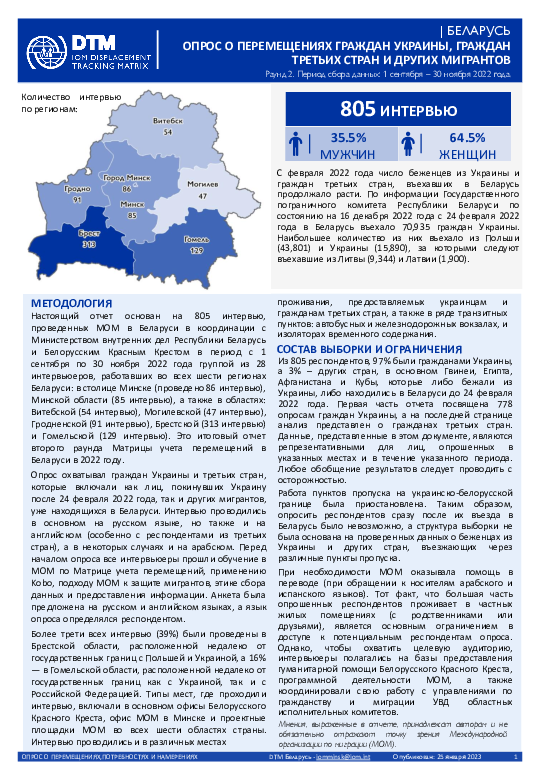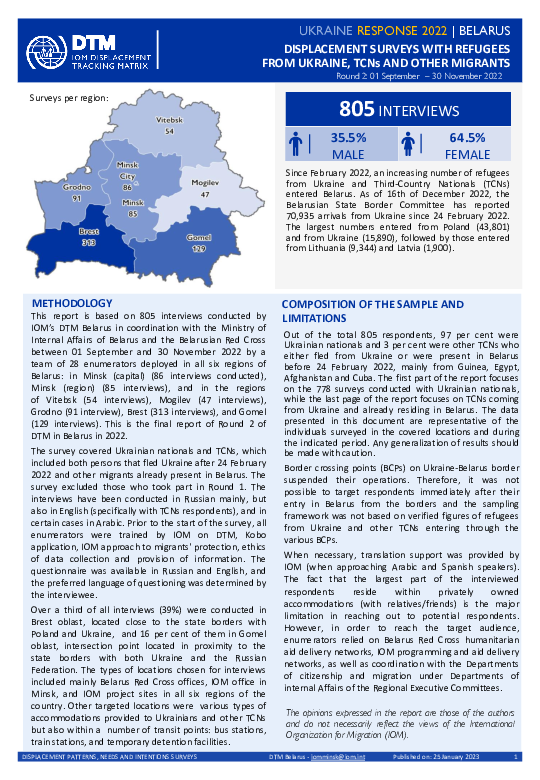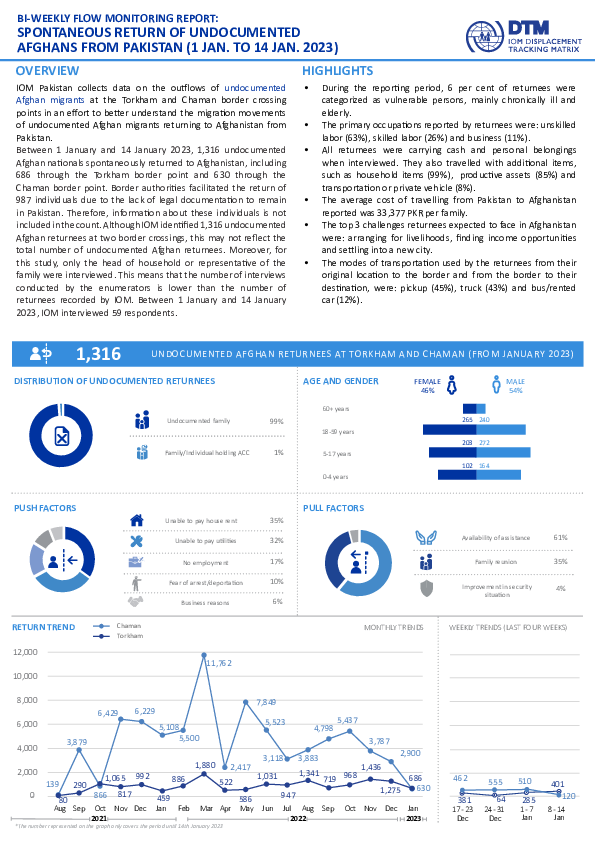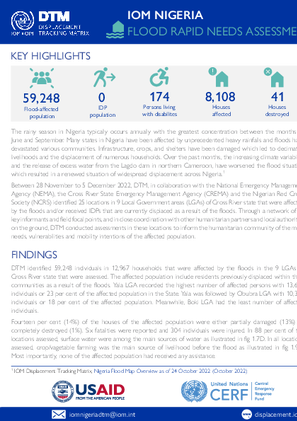-
Countries
-
Data and Analysis
-
Special Focus
-
Crisis Responses

Contact
DTM Europe, DTMMediterranean@iom.int
Language
Russian
Location
Belarus
Period Covered
Sep 01 2022
Nov 30 2022
Activity
- Survey
- Flow Monitoring
- Mobility Tracking
С февраля 2022 года число беженцев из Украины и граждан третьих стран, въехавших в Беларусь продолжало расти. По информации Государственного пограничного комитета Республики Беларуси по состоянию на 16 декабря 2022 года с 24 февраля 2022 года в Беларусь въехало 70,935 граждан Украины. Наибольшее количество из них въехало из Польши (43,801) и Украины (15,890), за которыми следуют въехавшие из Литвы (9,344) и Латвии (1,900).
Настоящий отчет основан на 805 интервью, проведенных МОМ в Беларуси в координации с Министерством внутренних дел Республики Беларусь и Белорусским Красным Крестом в период с 1 сентября по 30 ноября 2022 года группой из 28 интервьюеров, работавших во всех шести регионах Беларуси: в столице Минске (проведено 86 интервью), Минской области (85 интервью), а также в областях: Витебской (54 интервью), Могилевской (47 интервью), Гродненской (91 интервью), Брестской (313 интервью) и Гомельской (129 интервью). Это итоговый отчет второго раунда Матрицы учета перемещений в Беларуси в 2022 году.
Contact
DTM Iraq, IraqDTM@iom.int
Location
Iraq
Activity
- Mobility Tracking
- Baseline Assessment
Period Covered
Oct 01 2022 -Dec 31 2022
From May 2018 to December 2022, 46,578 Iraqi returnees from abroad were identified in 18 Governorates, 74 Districts and 723 l
oca tions. During this reporting period, IOM Iraq achieved full country coverage.
Population Groups
Survey Methodology
Unit of Analysis Or Observation
Type of Survey or Assessment
Keywords
Geographical Scope
Administrative boundaries with available data
The current dataset covers the following administrative boundaries
Contact
DTM Iraq, IraqDTM@iom.int
Location
Iraq
Activity
- Mobility Tracking
- Baseline Assessment
Period Covered
Oct 01 2022 -Dec 31 2022
During this round of data collection, DTM has identified 4,989,852 returnees (831,642 households), dispersed across 9 governorates, 39 districts and 2,208 locations in Iraq.
Population Groups
Survey Methodology
Unit of Analysis Or Observation
Type of Survey or Assessment
Keywords
Geographical Scope
Administrative boundaries with available data
The current dataset covers the following administrative boundaries
Contact
DTM Iraq, IraqDTM@iom.int
Location
Iraq
Activity
- Mobility Tracking
- Site Assessment
- Baseline Assessment
Period Covered
Oct 01 2022 -Dec 31 2022
During this round of data collection, DTM has identified 1,168,619 internally displaced persons (200,738 households), dispersed across 18 governorates, 104 districts and 2,694 locations in Iraq.
Population Groups
Survey Methodology
Unit of Analysis Or Observation
Type of Survey or Assessment
Keywords
Geographical Scope
Administrative boundaries with available data
The current dataset covers the following administrative boundaries

Contact
DTM Europe, DTMMediterranean@iom.int
Language
English
Location
Belarus
Period Covered
Sep 01 2022
Nov 30 2022
Activity
- Survey
- Flow Monitoring
- Mobility Tracking
Since February 2022, an increasing number of refugees from Ukraine and Third Country Nationals (TCNs) entered Belarus. As of 16th of December 2022, the Belarusian State Border Committee has reported 70,935 arrivals from Ukraine since 24 February 2022. The largest numbers entered from Poland (43,801) and from Ukraine (15,890), followed by those entered from Lithuania (9,344) and Latvia (1,900).
This report is based on 805 interviews conducted by IOM’s DTM Belarus in coordination with the Ministry of Internal Affairs of Belarus and the Belarusian Red Cross between 01 September and 30 November 2022 by a team of 28 enumerators deployed in all six regions of Belarus: in Minsk (capital) (86 interviews conducted), Minsk (region (85 interviews), and in the regions of Vitebsk (54 interviews), Mogilev (47 interviews), Grodno (91 interviews), Brest(313 interviews), and Gomel (129 interviews). This is the final report of Round 2 of DTM in Belarus in 2022.

Contact
DTM Pakistan, iomisbdtmremapteam@iom.int
Language
English
Location
Pakistan
Period Covered
Jan 01 2023
Jan 14 2023
Activity
- Flow Monitoring
IOM Pakistan collects data on the outflows of undocumented Afghan migrants at the Torkham and Chaman border crossing points in an effort to better understand the migration movements of undocumented Afghan migrants returning to Afghanistan from Pakistan. This exercise is part of the European Union funded project “Displacement Tracking Matrix Regional Evidence for Migration Analysis and Policy (DTM REMAP)”.
Between 1 January and 14 January 2023, 1,316 undocumented Afghan nationals spontaneously returned to Afghanistan, including 686 through the Torkham border point and 630 through the Chaman border point. Border authorities facilitated the return of 987 individuals due to the lack of legal documentation to remain in Pakistan. Therefore, information about these individuals is not included in the count. Although IOM identified 1,316 undocumented Afghan returnees at two border crossings, this may not reflect the total number of undocumented Afghan returnees. Moreover, for this study, only the head of household or representative of the family were interviewed. This means that the number of interviews conducted by the enumerators is lower than the number of returnees recorded by IOM. Between 1 January and 14 January 2023, IOM interviewed 59 respondents.
Contact
DTM Somalia Location
Somalia
Activity
- Mobility Tracking
- Event Tracking
Period Covered
Jan 07 2023 -Jan 12 2023
ETT is a crisis-based tool that tracks sudden displacement triggered by specific events or emerging crises. The objective of ETT is to help prioritize humanitarian response and to enable partners to deliver rapid assistance. Based on previous drought induced displacement patterns, and the ones observed since the beginning of the drought, the humanitarian community expects that people will move from rural to urban areas in search of humanitarian services. Consequently, this ETT tool which concentrates only on drought induced displacements, focuses on the main urban centers and surrounding villages for each district. The data is collected through Key Informant Interviews (KIIs) at the location level, from Sunday to Wednesday every week. All locations assessed are monitored each week.
Population Groups
Survey Methodology
Unit of Analysis Or Observation
Type of Survey or Assessment
Keywords
Geographical Scope
Administrative boundaries with available data
The current dataset covers the following administrative boundaries

Contact
DTM Nigeria, AllUsersInDTMNigeria@iom.int
Language
English
Location
Nigeria
Period Covered
Jul 01 2022
Sep 30 2022
Activity
- Flow Monitoring
In order to gain a better understanding of mobility flows and trends throughout West and Central Africa, the International Organization for Migration (IOM) implements the Displacement Tracking Matrix’s Flow Monitoring (FM) tool at key transit points across the region.
Flow Monitoring activities are conducted in close cooperation with national and local authorities as well as with local partners. The Flow Monitoring tool consists of two main components: the Flow Monitoring Registry (FMR), which captures key data on the magnitude, provenance, destination and mode of travel of mobility flows, and the Flow Monitoring Survey (FMS), individual surveys conducted with travellers to gather detailed information about the profiles, migration experience, and intentions of migrants. Through these activities, the Flow Monitoring tool collects data on migration flows and trends, traveller profiles, migration journeys, and intentions of migrants, so as to obtain a sharpened view of mobility in West and Central Africa.
In Nigeria, DTM conducts Flow Monitoring activities in several important transit locations in Sokoto and Kano to monitor the movements of passenger buses to and from Niger. The Sokoto FMP covers three migratory routes in Illela, Gada and Sabon-Birnin. And the Kano FMP (Kofar Ruwa Park and Yankaba Park) covers two migratory routes in Dala and Nasarawa Local Government Areas in Kano state.
This report is subdivided into two sections: one section presents data obtained during the FMR and another section presents the key results from the FMS conducted with travellers between July and September 2022. The report presents data collected on flows, routes, provenance, destination and demographic profiles of travellers observed at the FMPs.

Contact
DTM Nigeria, iomnigeriadtm@iom.int
Language
English
Location
Nigeria
Period Covered
Nov 28 2022
Dec 05 2022
Activity
- Event Tracking
The rainy season in Nigeria typically occurs annually with the greatest concentration between the months of June and September. Many states in Nigeria have been affected by unprecedented heavy rainfalls and floods have devastated various communities. Infrastructure, crops, and shelters have been damaged which led to decimated livelihoods and the displacement of numerous households. Over the past months, the increasing climate variability and the release of excess water from the Lagdo dam in northern Cameroon, have worsened the flood situation which resulted in a renewed situation of widespread displacement across Nigeria.
Between 28 November to 5 December 2022, DTM, in collaboration with the National Emergency Management Agency (NEMA), the Cross River State Emergency Management Agency (CREMA) and the Nigerian Red Cross Society (NCRS) identified 59,248 individuals in 12,967 households that were affected by the floods in the 9 LGAs of Cross River state that were assessed.

Contact
DTM Mali, DTMMali@iom.int
Language
French
Location
Mali
Period Covered
Sep 01 2022
Sep 30 2022
Activity
- Survey
- Displacement Solutions
L’année 2022 est marquée par des mouvements de populations très complexes, avec des cas de retour, y compris des retours non réussis, des déplacements de courte durée ont continué également a être signalés dans différentes régions du pays. Une proportion importante de personnes déplacées internes vivaient encore dans les centres urbains du pays dans des conditions précaires et avec des besoins d’assistances permanents, le reste de la population déplacée étant dispersée dans les zones rurales, dans des familles d’accueils ou sur des sites auto-installés. L’amélioration des conditions de sécurité dans certaines localités a permis de faciliter le retour de certains ménages, mais de nombreux obstacles persistent, les empêchant de trouver des solutions durables à leur déplacement.
Afin de trouver des solutions durables au déplacement interne - que ce soit par le retour dans les localités d’origine, l’intégration locale ou la réinstallation - et de prévenir de nouveaux déplacements dans les différentes régions, il est essentiel de comprendre les niveaux relatifs de stabilité dans les lieux accueillant des retournés ou des populations déplacées internes. Par conséquent, la Direction Nationale du Développement Social (DNDS) en collaboration avec l’OIM, a lancé l’enquête de l’Indice de Stabilité (IS) pour évaluer la stabilité des zones accueillant des retournés ou des populations déplacées. L’IS cherche à comprendre quels facteurs influencent la stabilité d’un lieu, ce qui peut éclairer les interventions programmatiques prioritaires le long du lien humanitaire, de paix et de développement afin de renforcer la résilience et la stabilité et de prévenir de futurs déplacements forcés.